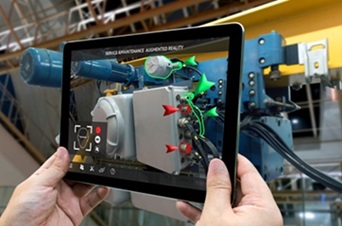AI and Industrial Automation: The Ultimate Solution to Manufacturers’ Challenges in 2024

The manufacturing industry faces a confluence of challenges: rising material costs, supply chain disruptions, and ever-evolving customer demands. In this turbulent environment, manufacturers are actively seeking technological solutions to bolster their resilience, efficiency, and competitive edge. The synergistic combination of artificial intelligence (AI) and automation represents the ‘ultimate antidote’ for manufacturers seeking to unlock peak efficiency, performance, and productivity.
Quality Control: Pushing the boundaries of precision and efficiency
Instances of manufacturers failing to meet safety or performance standards can have significant repercussions, encompassing costly recalls, legal actions, high service costs, and reputational damage. Conventional quality control methods are time-consuming, labor-intensive, and susceptible to human error, amplifying the above-mentioned issues. A powerful alliance of artificial intelligence (AI), automation, and computer vision solutions presents a transformative opportunity for quality control. It can empower production lines to leverage robots equipped with AI-powered vision systems to accurately perform intricate assembly tasks. Trained on sophisticated AI models and algorithms, these bots utilize specialized cameras and sensors to capture high-resolution images of products traversing conveyors or processed by robotic arms.
By integrating Optical Character Recognition (OCR) and Intelligent Character Recognition (ICR), these systems can effectively identify alphanumeric characters and handwritten text, enhancing their capability to detect defects and discrepancies in labeling and packaging. Advanced algorithms, such as convolutional neural networks (CNNs) and recurrent neural networks (RNNs), are employed to analyze these images with unparalleled precision, identifying even the subtlest defects—cracks, deformities, dents, and discolorations—that might elude the human eye. Deep Reinforcement Learning (DRL) further allows these autonomous systems to continuously learn and refine their decision-making by adapting to evolving quality standards and production processes over time. For instance, poultry processors are embracing the future with real-time, AI-powered quality control. High-speed cameras meticulously capture every detail along the processing line, transmitting images to sophisticated algorithms. These algorithms, trained on extensive datasets, swiftly detect undercooked or contaminated chicken pieces. Identified flaws are promptly flagged for immediate intervention, ensuring they never reach consumers. Additionally, the system generates insightful reports, allowing processors to continuously monitor and improve their quality control processes. This innovative approach ensures food safety, minimizes waste, and ultimately delivers a consistently superior chicken product from farm to fork.
Taming the Unexpected: Driving agility & responsiveness
In the dynamic landscape of modern manufacturing, the shift from reactive to proactive risk mitigation strategies is imperative to drive agility and resilience. This necessitates the continuous monitoring of operational processes to detect delays and variances, promptly identify their impacts, and address potential disruptions. The rise of Generative AI and automation can play a pivotal role in enhancing visibility, velocity, and responsiveness across the value chain. These advanced technologies enable a more proactive, tailored, and efficient approach to risk management compared to traditional methods.
Generative AI models, when pre-trained on certain parameters, can streamline risk assessment by automating the categorization and prioritization of risks based on factors such as locations, production lines, commodities, suppliers, and customers. In case of a disruption, these technologies can swiftly analyze real-time inventory levels, check production schedules, and identify alternate procurement sources, minimizing the impact of risk events on the supply chain and operations, hence safeguarding against cascading disruptions. They can also auto-generate customized risk reports, facilitate crisis communication to internal and external stakeholders, and devise mitigation plans tailored to organizational priorities, ensuring operational resilience. The integration of generative AI and automation empowers manufacturers to navigate uncertainties with precision, ensuring the lights never go off and engines keep running.
Prioritizing Customer Experience: Driving profits and trust
In today’s experience age, exceeding customer expectations is no longer a ‘nice-to-have’, it’s a necessity. Historically, internal metrics like production speed and cost control dominated manufacturing operations. However, AI empowers manufacturers to unlock the power of vast customer data sets. By gleaning insights into customer needs, preferences, and buying behaviors, manufacturers can make data-driven decisions that directly impact the customer journey. Real-time demand forecasts facilitated by AI enable dynamic adjustments to manufacturing processes, ensuring on-time deliveries and minimized stockouts—both critical factors for achieving superior customer satisfaction.
Moreover, the convergence of AI, automation, and computer vision unlocks a new era of remote troubleshooting in field service. Leveraging the trio, field technicians can visually inspect equipment and components from afar. Embedded cameras and sensors within deployed products can seamlessly feed high-resolution images and video data to computer vision systems. These systems, buoyed by AI algorithms, can analyze the data, enabling technicians to remotely access equipment conditions and identify potential issues. This eliminates unnecessary on-site visits and empowers technicians to troubleshoot problems in real-time, regardless of location. This translates to a more reliable and responsive service experience for customers.
Bottom Line
The manufacturing industry is in an exciting phase, poised for a transformative leap fueled by the convergence of AI and automation. As we peer into the horizon of manufacturing, propelled by the relentless march of AI and automation, the trajectory ahead is one of unprecedented possibility and innovation. The convergence of these technologies heralds not just incremental improvements, but a wholesale transformation of how we conceive, design, produce, and deliver goods. This future of AI + Automation collaboration promises a manufacturing landscape characterized by exceptional efficiency, flexibility, and boundless innovation.

Raju Rampa
Chief Growth Officer
Innover Digital
Image Source: Magic Wand Media




 Facebook
Facebook.png) Twitter
Twitter Linkedin
Linkedin Subscribe
Subscribe